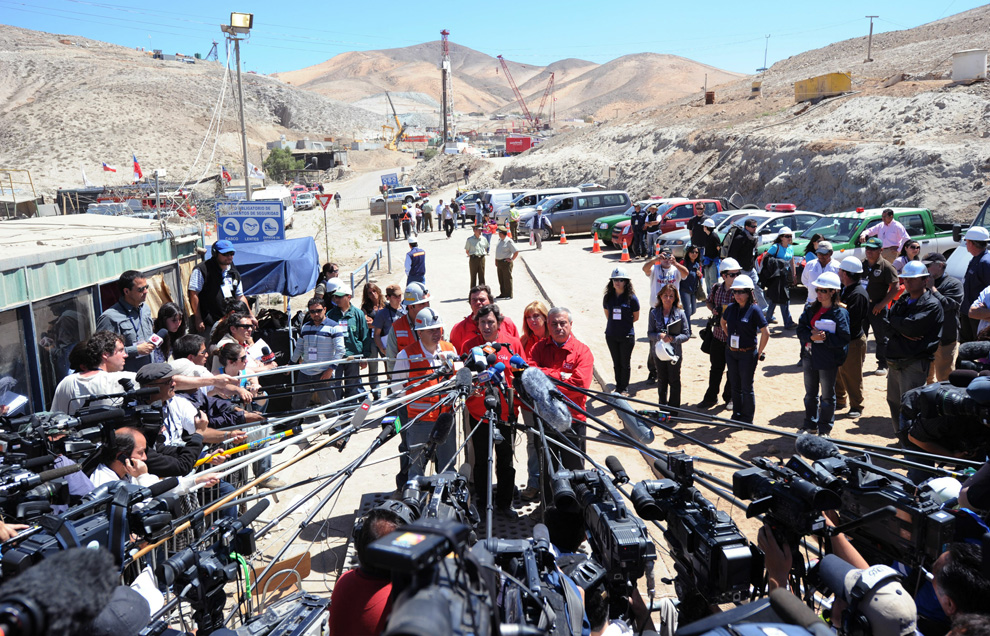http://www.cbc.ca/world/story/2010/1...ne-rescue.html
The painstaking but time-consuming process of bringing of 33 Chilean miners to the surface after 69 days underground began late Tuesday with the first being rescued at 11:11 p.m. ET.
Florencio Avalos, 31, stepped out of the metal rescue capsule moments later as the crowd cheered and horns blew. He was greeted by his wife, two sons and father. His son, Bairon, 7, sobbed.
Avalos hugged his rescuers and Chilean President Sebastian Pinera before being escorted into a medical triage centre set up on site.
Florencio Avalos is videotaped moments after his rescue late Tuesday from a gold and copper mine near Copiapo, Chile. (Associated Press)
Avalos was raised more than 600 metres through a rescue shaft while strapped into a 190-by-54-centimetre capsule. His journey began at 10:55 p.m. ET and took just 16 minutes.
Before his rescue, crews ran tests by lowering an empty capsule down the shaft and raising it before sending it back down with a rescue worker inside to help prepare the miners for their trip to the surface.
About 20 minutes after Avalos emerged, a second rescue worker was strapped into the capsule and it was lowered down the shaft again.
It returned to the surface with a second miner, Mario Sepulveda, at about 12:10 a.m. ET. A third miner followed about an hour later.
The miners — who were trapped underground at the gold and copper mine near Copiapo, Chile, on Aug. 5 — are being hoisted to the surface one at a time through the shaft, which has taken weeks to drill.
Relatives and friends celebrate as they watch the Avalos rescue, which was broadcast on a big screen TV near the mine. (Dario Lopez-Mills/Associated Press)
The capsule, dubbed Phoenix 1, was taking a little more than 15 minutes to make each one-way trip. The winch that raises the capsule was expected to move at a speed of 0.7 metres per second, but the capsule can be pulled as fast as three metres per second if needed. Two additional capsules have been built to serve as backup if necessary.
Shortly before the rescue was due to start, the president teased reporters at a news conference that he was pretty sure the first one out would have the last name of Avalos. There are actually three men with that name trapped below.
But Maria Silva said the president himself had told her it would be her son Francisco.
Avalos, described by friends as shy, had been the group's second-in-command before the collapse and often acted as a cameraman after cameras were sent down, taking pictures of the other miners — a role that frustrated relatives who saw little of him in the videos.
"I am not surprised" he was chosen, his mother Maria said after word reached the family. "I am so proud of him."
Psychologists, Chile's health minister and doctors at the site say it will be a perilous journey for the miners.
Doctors say the miners could suffer nausea and heart palpitations and are concerned about the risk of blood clotting and heart attacks. Aspirin had been sent down to the men to thin their blood.
Miners monitored during ascent
The miners are closely monitored from the moment they are strapped in the capsule. They had been given a high-calorie liquid diet donated by NASA, designed to keep them from vomiting as the capsule rotates.
A video camera in the capsule is used to monitor for panic attacks. The miner uses an oxygen mask and has two-way voice communication.
They also wear sweaters because of the shift in climate from about 30 C underground to near freezing on the surface after nightfall. Those coming out during daylight hours will wear sunglasses.
After medical checks and visits with family members selected by the miners, the men will be flown to hospital in Copiapo, a 10-minute ride away. Two floors were prepared where the miners will receive physical and psychological exams and be kept under observation in a ward as dark as a movie theatre.
The last miner who will leave the mine has already been decided — shift foreman Luis Urzua, whose leadership was credited for helping the men endure 17 days with no outside contact after the collapse. The men made 48 hours worth of rations last before rescuers reached them with a narrow borehole to send down more food.
Read more:
http://www.cbc.ca/world/story/2010/1...#ixzz12DHo34KO 
 You are currently viewing our boards as a guest which gives you limited access to view most discussions and access our other features. By joining our free community you will have access to post topics, communicate privately with other members (PM), respond to polls, upload content and access many other special features. Registration is fast, simple and absolutely free so please, join our community today!
The banners on the left side and below do not show for registered users!
You are currently viewing our boards as a guest which gives you limited access to view most discussions and access our other features. By joining our free community you will have access to post topics, communicate privately with other members (PM), respond to polls, upload content and access many other special features. Registration is fast, simple and absolutely free so please, join our community today!
The banners on the left side and below do not show for registered users!







